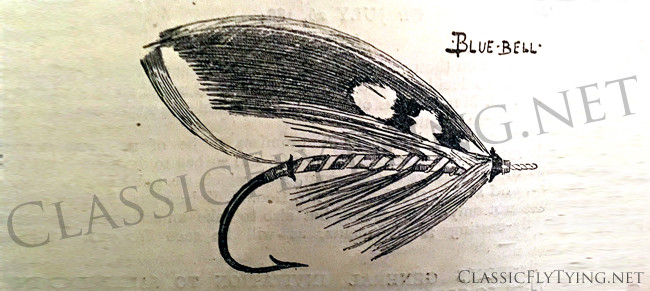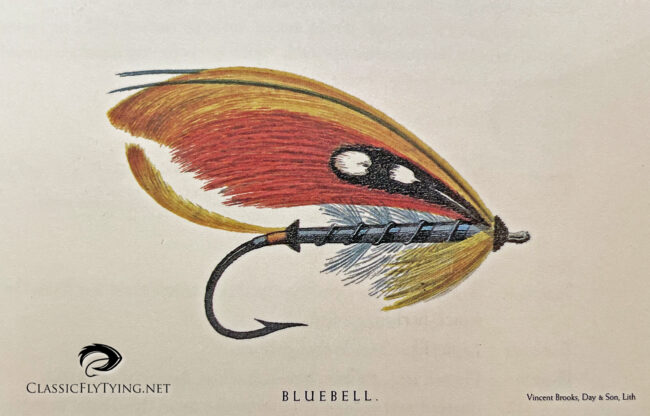By Mr. Geo. M. Kelson
Fishing Gazette – May 31, 1884
First Article on the Description of Salmon Flies
I did not intend, until the standard colours were introduced, to commence this subject; but is has been suggested to me that, as some of Major Traherne’s patterns were made pretty much with natural material, undyed, I might start this series of articles by illustrating a few of them.
When the standard colours are established, there should be no difficulty whatever in dressing any specimen if it were properly described. It is most disappointing to a salmon fisherman not to be able to get a fly true to pattern – indeed, it is most annoying.
Who has not heard, at one time or another, that “deep sigh” when a new packet of flies has been undone? Does not hat sigh suggest all kinds of unmentionable curses?
Now I am almost of opinion that if all the corduroy gods of calumny were to shower their “Billingsgate brogue” upon some of our persistent, though innocent, manufacturers, it would not prevent odd bits of material – patches of pothouse plumes – being whipped in for the cloak of convenience, which we all so frequently see disfiguring many of their samples.
There really is but one remedy to override this whirlwind of such a contemptible custom, and to overcome this increasing violation, this incorrect and inharmonious dressing; just put “Not known” and, like a dead letter, return the parcel of profaned patterns to the maker.
I am occasionally witnessing the work of one or two of our best men, which “speaks for itself” to anyone who is familiar with the standard patterns; it is naturally well done, and that, too, from memory. Even they would do well to sacrifice this “straightforward reflection”, and work upon principle. Let almost anyone advertise and dress flies made true to standard patterns – they would soon glory in their success; they would soon make for themselves a tower of reputation which no thunder-crash could lower, no storm of time destroy.

Major Traherne’s Patterns of Salmon Flies – No. 1.
“Bluebell” is one of the most useful flies I have seen for many years. Dressed to the required size, it would probably move the sulkiest fish in any river. It has for some time proved itself a tip-top fly. and it is made as follows:
Tag: Silver twist, and blue silk the same shade as the Macaw feathers.
Tail: A topping.
Butt: Black herl.
Body: Orange silk, to the part on the hook midway between the throat and the tag; the rest blue silk. The former the same shade as the rind of a darkish orange, the latter the same as in the tag.
Ribs: Silver lace and silver twist.
Hackle: Blue Macaw, from blue silk
Throat: Yellow Macaw.
Wing: Red Macaw.
Sides: Jungle Fowl.
Horns: Blue Macaw with a topping over.
Head: Black Ostrich herl.
There are no salmon flies in creation requiring so much patient work to dress well as Major Traherne’s. This one is a very simple pattern comparatively, and could be made at a quarter the price of many of his others.
This gentleman, in the stream of Time from practical experience, has stored rare stock of the great and fundamental truths in angling, and also of the laws of its operation, which are undoubtedly as fixed and unalterable as those which govern the stars.
He has availed himself of every opportunity to develop his talent; he has hurried away from what is generally styled “that snug retreat”-Self; and he is doing the piscatorial world a real good turn by allowing his brilliant patterns to be published, which, in many rivers, are simply irresistible.
Land & Water Publication
It is important to understand that the folloing article comes from Land & Water Magazine, not the later Land & Water Cards…

The theory upon which Bluebell is designed is that the red macaw wing in strands is particularly showy in bright water, and attracts fish when most of the old stardards have been proven useless. In addition to this it had been discovered that the natural (i.e. undyed) hackles, consisting here of yellow macaw and blue macaw, have a power of attraction which cannot be possessed by dyed feathers. But full benefit of the combination will not be obtained unless great care be taken in the manner in which it is presented to the fish.
Red macaw, in extra long strands, as illustrated, has an awkward trick of getting jumbled up into a confused and disordered condition unless the fly be worked in a direct line with the course of the stream. Any attempt to draw it across the current will immediately cause the wing on the upper side to lean over, the whole forming a clumsy and unsightly mass, which not only scares the fish but puts them off so completely that they refuse this or any other fly which might be tried afterwards.
On the other hand, when the fly is properly played in a direct line with the stream, the feathers expand and close in that graceful and attractive way which few salmon will resist. In order to ensure this result some attention is required on the part of the dresser. Unless the strands are put on correctly no one can fish the fly. Major Traherne is the master of infinite elaboration, and he knows too well that these fibres, being scythe-shaped, the side of the strand has to lie at the side of the hook whilst the first two or three turns of the silk are being made. They are then lifted up by the waste into their proper position. And everyone should know that the right hand side of the feather serves for the purpose of building the left wing. The arch-like tendency in nearly every feather directs the unenlightened dresser which side of hte hook his strip is intended for.
As red macaw in short strands has but little animation in the water, Bluebell is of no use tied small.

